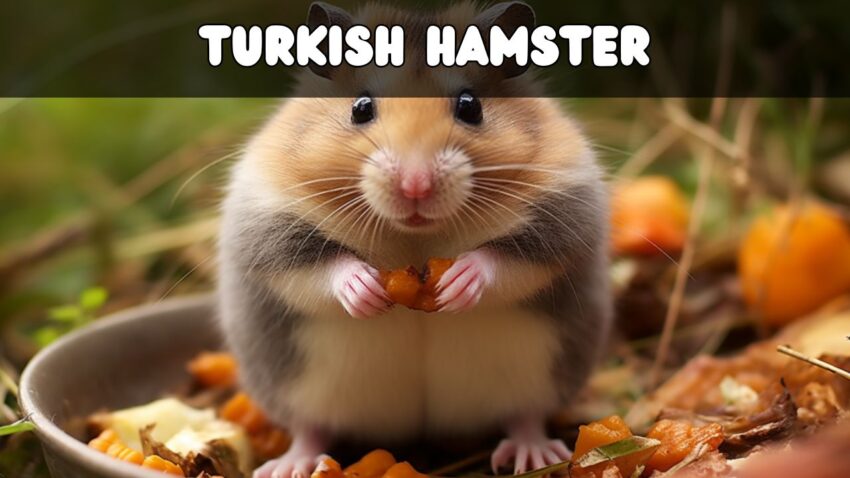The world of hamsters is vast and varied, each species bringing its own charm and unique characteristics. Among these captivating creatures stands the Turkish Hamster, a true testament to nature’s artistry and wonder. These rodents, with their delightful quirks and undeniable appeal, have managed to win the hearts of many, from casual observers to dedicated pet enthusiasts.
Welcoming the Turkish Hamster: Nature’s Mesmerizing Rodent
For those unfamiliar, the Turkish Hamster emerges as a hidden gem in the diverse realm of rodents. As its name suggests, this species originates from the majestic landscapes of Turkey, boasting a rich history and a natural allure that few can resist. Their petite size, combined with distinctive features, makes them a sight to behold, an embodiment of nature’s meticulous craftsmanship.
A Comprehensive Look into the Life and Care of the Turkish Hamster
In this guide, we will embark on a journey that unravels the mysteries and wonders surrounding the Turkish Hamster. From understanding its natural habitat and behaviors to ensuring its health, wellness, and proper care, our exploration will offer insights and answers to all things related to this fascinating species. Whether you’re considering adopting one or merely intrigued by their existence, this guide aims to provide a thorough understanding of what it means to be a Turkish Hamster in both the wild and our homes.
Overview

The Turkish Hamster, a lesser-known gem among rodent enthusiasts, carries with it tales from the vast landscapes of Turkey to the cozy corners of domestic habitats. While some species of hamsters have gained immense popularity as household pets, the Turkish variant remains an understated marvel, awaiting discovery. In this section, we’ll journey through an intriguing contrast: the life of the wild wanderer and its counterpart, the domesticated delight. As we delve deeper into the dual existence of this unique species, we’ll gain a richer understanding of its nature, needs, and nuances.
The Turkish Hamster: A Brief Overview
The Turkish Hamster, often overshadowed by its more popular counterparts, possesses a charm that’s uniquely its own. This captivating rodent, native to the vast landscapes of Turkey, offers a blend of characteristics that make it a notable member of the hamster family. While it might not be the first choice for every potential pet owner, those who’ve had the pleasure of its company can vouch for its distinct appeal.
Domesticated Delight vs. Wild Wanderer: Its Dual Existence
In the wild, the Turkish Hamster is a resourceful and adaptive creature, navigating the challenges of its natural habitat with finesse. It thrives in the varied terrains of its homeland, showcasing behaviors that are a testament to its resilience and survival instincts.
Contrastingly, in domestic settings, the Turkish Hamster exhibits a different side. As pets, they transform into delightful companions, showcasing a temperament that’s both endearing and manageable. Their domesticated existence, while contrasting from their wild life, highlights their adaptability, further proving their versatility as a species. Whether roaming free in the vastness of Turkey or snuggled comfortably in a home setup, the Turkish Hamster stands as a testament to nature’s diverse creations.
Natural Habitat

The Turkish Hamster, while often seen scurrying in domestic settings, hails from the diverse landscapes of Turkey. This region, steeped in natural beauty and a mosaic of climatic conditions, shapes the behaviors, dietary habits, and lifestyles of these fascinating rodents. Before we delve into the intricacies of their domestic care, it’s essential to understand the environment they naturally inhabit. By doing so, we gain profound insights into their needs, preferences, and behaviors, ensuring they live healthy and happy lives whether in the wild or in our homes.
The Turkish Hamster’s Native Terrain
The Turkish Hamster predominantly thrives in the diverse terrains of Turkey, a country that boasts a rich tapestry of landscapes. These hamsters are primarily accustomed to the grasslands, rolling hills, and open plains where they burrow and create intricate tunnel systems. Their burrows not only offer shelter from predators but also provide an escape from the region’s occasional extreme temperatures. These underground homes are often multi-chambered, with areas designated for food storage, nesting, and waste.
In the wild, Turkish Hamsters generally steer clear of densely forested regions, preferring instead the accessibility of open spaces where they can forage for food and keep an eye out for predators. These hamsters are also known to inhabit agricultural fields, where they can often find an abundance of grains and seeds, which are essential components of their diet.
The Essential Climatic and Geographic Factors
Turkey’s climate, with its unique positioning between Europe and Asia, offers a blend of Mediterranean, oceanic, and continental climatic conditions. The Turkish Hamster’s natural habitat experiences warm summers and cold winters, with variations in temperature depending on the specific region. For instance, the coastal areas have milder temperatures year-round, while the inland regions can face harsher extremes.
The geographic factors, such as altitude and proximity to water bodies, further influence the microclimates within their habitat. While the Turkish Hamster has evolved to withstand a range of temperatures, it’s crucial to understand that their burrowing behavior is a natural adaptation to protect against both sweltering heat and freezing cold. The soil quality, vegetation type, and availability of fresh water sources in their native regions also play a significant role in their lifestyle, dictating their dietary habits, breeding cycles, and daily routines.
This understanding of their natural habitat is not just academic; it plays a crucial role for those who wish to provide the most natural and comfortable living conditions for Turkish Hamsters in captivity.
Physical Characteristics

The physical attributes of the Turkish Hamster set it apart in the realm of small rodents. Not only are these creatures a delight to observe, but their distinctive features also make them a favorite among enthusiasts and pet owners alike. Let’s explore the physical nuances of this species, understanding what truly makes the Turkish Hamster a unique specimen.
The Beauty of the Turkish Hamster: Size, Color, and Physicality
The Turkish Hamster typically measures between 6 to 8 centimeters in length, with males being slightly larger than females. Their compact size, coupled with a rounded body, gives them an endearing appearance. Their fur, which is a symphony of colors ranging from light beige to golden brown, often has darker patterns on the back, while their underbelly remains a lighter shade, offering a delightful contrast.
Apart from their coloration, another noticeable feature is their cheek pouches. These stretchy sacs allow them to store food, which they can carry back to their burrow and consume later. Their petite ears, sharp eyes, and a somewhat stubby tail add to their overall charm, making them irresistible to those who encounter them.
Physical Adaptations: The Turkish Hamster’s Evolutionary Gifts
Nature, with its infinite wisdom, has equipped the Turkish Hamster with several physical adaptations that have allowed it to survive and thrive in its native environments. These adaptations are not just functional but also play a role in making the Turkish Hamster a captivating creature to observe.
One of the most remarkable physical features of the Turkish Hamster is its cheek pouches. These extendible storage sacs run from its cheeks to its shoulders, allowing it to gather and store copious amounts of food. This feature proves particularly useful when foraging, enabling the hamster to gather more food in a single trip, thereby reducing its exposure to predators.
Additionally, the Turkish Hamster’s nimble feet are designed for both digging and rapid movement. Their claws are perfectly adapted for burrowing into the ground, creating intricate tunnel systems where they can hide from potential threats and store food. Moreover, the positioning and structure of its feet aid in quick movements, enabling the hamster to swiftly navigate its environment, whether escaping from a potential threat or chasing after a meal.
Lastly, their sharp senses, especially their sense of hearing and smell, are paramount in their daily activities. These heightened senses alert them to the presence of both predators and food sources, ensuring their survival in the wild.
In understanding these evolutionary gifts, we gain a deeper appreciation for the intricate balance of beauty and function that the Turkish Hamster embodies.
Behavior and Temperament

The Turkish Hamster, like all creatures, displays behaviors and temperaments molded by evolution, environment, and genetics. Understanding these traits not only aids potential pet owners in providing suitable care but also cultivates a deeper appreciation for these petite wonders of nature.
Personality Unfolded: The Turkish Hamster’s Behavior
The Turkish Hamster, primarily a nocturnal creature, tends to be most active during the early evening to dawn. This behavior can be attributed to their natural instinct to avoid daytime predators and to forage under the cover of darkness. In the wild, they have developed a keen sense of alertness, always on the lookout for potential threats. This heightened vigilance often translates to a certain level of skittishness, especially in unfamiliar environments or when introduced to sudden movements or noises.
Socially, while they might exhibit some territorial tendencies, especially among males, Turkish Hamsters can sometimes be amicable when introduced to companions at a young age. It’s crucial, however, to monitor their interactions and ensure they have ample space to avoid territorial disputes.
In their natural environment, their behavior also includes extensive burrowing. They construct intricate underground networks, serving as homes, food storage areas, and escape routes. This digging behavior often carries over into captivity, where they might be seen burrowing in their bedding or creating tunnels if provided with suitable materials.
Special Traits and Unique Behaviors that Set Them Apart
One intriguing behavior observed in the Turkish Hamster is their methodical approach to food storage. Using their expansive cheek pouches, they gather food and transport it back to their burrows, creating designated storage areas. This hoarding behavior is an evolutionary response to uncertain food availability in the wild, ensuring they have reserves during lean times.
Additionally, Turkish Hamsters have a fascinating grooming ritual. Using their forelimbs, they frequently clean their fur, ensuring it remains in top condition. This meticulous grooming not only keeps them clean but also aids in scent-marking, an essential communication method, especially during mating seasons.
When it comes to communication, these hamsters have a series of vocalizations, from soft chirps to more assertive squeaks, each signifying different emotions or intentions. These vocal cues, combined with physical postures, play a pivotal role in their social interactions, whether it’s attracting a mate or establishing dominance.
In sum, the behavior and temperament of the Turkish Hamster are a blend of evolutionary adaptations, environmental influences, and inherent personality traits. Recognizing and understanding these behaviors fosters a harmonious relationship between these delightful rodents and their caregivers.
Diet and Nutrition

Feeding your Turkish Hamster properly isn’t just about ensuring they have food in their bowl. It’s about understanding the dietary nuances that cater to their unique needs, ensuring a balance between nourishment, enjoyment, and health. The Turkish Hamster’s diet, much like that of other hamster species, is rooted in its natural eating habits, which are adapted to the environments they hail from.
The Turkish Hamster’s Culinary Preferences
In their wild habitats, Turkish Hamsters are opportunistic omnivores. They primarily consume a diet of seeds, grains, nuts, fruits, and vegetables. However, they are also known to eat small insects and other protein sources when available, which adds a necessary component to their diet. Their tendency to hoard food, a behavior that is ever-present in the wild to safeguard against times of scarcity, will often be seen in captivity as well.
While fresh foods like leafy greens, fruits (in moderation due to sugar content), and vegetables are enjoyed, it’s essential to ensure that these are introduced gradually to avoid digestive upset. Foods high in water content, such as cucumbers and lettuce, should be given sparingly to prevent diarrhea. Additionally, foods like onions, garlic, chocolates, and high-citrus fruits should be avoided entirely as they can be harmful.
Nourishing Them Right: Dietary Needs and Requirements
A Turkish Hamster’s primary diet in captivity should consist of a high-quality commercial hamster food mix, which ensures they receive the right balance of nutrients. These mixtures are designed to be complete and balanced, often comprising seeds, pellets, grains, and sometimes dried fruits. However, do ensure you pick a brand that’s reputable and avoids fillers or excessive sugary treats.
Given their omnivorous nature, introducing small amounts of animal protein can be beneficial. This can be in the form of mealworms, crickets, or even a small piece of boiled chicken or turkey occasionally.
Fresh water should always be available, typically provided in a sipper bottle to ensure cleanliness.
Supplements can be considered if you suspect a deficiency, but it’s always recommended to consult a veterinarian before introducing anything new. For instance, if the fur appears dull or the hamster seems lethargic, it might indicate a need for specific vitamins or minerals.
Remember, while feeding is an essential aspect of care, monitoring your hamster’s health through its dietary habits is equally vital. Any sudden change in eating patterns or preferences should be noted and addressed, possibly with a vet consultation.
To wrap it up, nourishing your Turkish Hamster correctly is a blend of understanding their natural tendencies and adapting to their individual needs. With a bit of attention to detail, you can ensure your furry friend enjoys a diet that keeps them active, healthy, and happy.
Housing and Environment

The Turkish Hamster, like all rodents, requires a safe, spacious, and stimulating environment to thrive. Proper housing not only ensures their physical well-being but also attends to their mental health, ensuring they remain active and engaged. A hamster’s cage is their world, and for the Turkish Hamster, a blend of their native environment and a comfortable domestic setting can make all the difference.
Crafting a Comfortable Abode for the Turkish Hamster
When it comes to selecting the right habitat for a Turkish Hamster, size is paramount. These hamsters are active and need ample space to move, explore, and play. A minimum cage size of 24 x 12 x 12 inches is recommended, but bigger is always better. Multi-level cages are also an excellent choice, providing vertical space for climbing and exploration.
The cage should be escape-proof but well-ventilated. Wire cages with a solid base or glass aquariums with mesh tops are popular choices. However, ensure the spaces between the wires are narrow enough to prevent escapes and avoid any potential injuries.
Within this space, it’s essential to create zones: a sleeping area, a feeding zone, a toilet corner, and a play/exercise region. Providing hiding spots, such as small boxes or commercially available hideouts, can offer your hamster a sense of security and privacy.
Housing Specifications, Bedding Materials, and Ambient Conditions
- Bedding: The choice of bedding is crucial, as the Turkish Hamster will spend a lot of time burrowing and nest-building. Aspen shavings or paper-based beddings are commonly recommended due to their absorbent nature and safety. Cedar or pine shavings should be avoided, as the oils can be harmful to hamsters.
- Wheel: An exercise wheel is a must-have. Ensure it’s solid-surfaced to prevent any foot injuries and is of an appropriate size to avoid back issues (a diameter of at least 8 inches is recommended).
- Toys and Enrichment: Hamsters are curious creatures. Providing toys, tunnels, and chewables can keep them mentally stimulated. Rotate toys to keep their environment fresh and engaging.
- Temperature: Turkish Hamsters prefer temperatures between 65°F to 75°F (18°C to 24°C). Ensure they are kept away from direct sunlight, drafts, and radiators.
- Cleanliness: Regular cleaning is vital for a healthy hamster. Remove soiled bedding daily, and a complete cage clean should be done every week to ten days, replacing old bedding and disinfecting the cage.
- Food and Water: Fresh water should be available at all times, preferably in a sipper bottle to ensure cleanliness. Food dishes should be sturdy and not easily tipped over.
- Location: Place the cage in a quiet location, free from excessive noise, but where the hamster can still observe and feel a part of the household.
In essence, creating the perfect habitat for a Turkish Hamster is a blend of understanding their natural inclinations and ensuring their safety. An environment that echoes their wild habitat while offering the comforts of domestic life will ensure your Turkish Hamster not only survives but thrives.
Health and Wellness

Like all pets, the Turkish Hamster requires vigilant care to maintain its optimal health. Understanding their common health concerns and actively preventing them can ensure a long, vibrant life for your furry friend. Furthermore, being able to quickly identify symptoms of distress or disease can make a difference in the outcome, especially given the small size and fragile nature of these creatures.
Maintaining the Turkish Hamster’s Health: Common Concerns and Solutions
1. Wet Tail: This is a common and serious condition in hamsters, characterized by diarrhea and a wet appearance around the tail. It’s usually caused by stress, abrupt changes in diet, or unsanitary living conditions. Immediate vet attention is required.
Solution: Ensure a stress-free environment, gradual diet changes, and maintain a clean habitat.
2. Respiratory Issues: Symptoms include sneezing, labored breathing, and nasal discharge. Causes can range from drafts, unsuitable bedding, or infections.
Solution: Keep the cage away from drafts, use dust-free bedding, and ensure cleanliness. If symptoms persist, consult a vet.
3. Overgrown Teeth: Hamsters’ teeth grow continuously. If they don’t wear down naturally, they can become too long, leading to eating difficulties.
Solution: Provide chew toys and hard foods like nuts or carrots to naturally wear down their teeth. Regularly check their teeth, and if overgrown, they might need trimming by a vet.
4. Skin Conditions: Dry, flaky skin, hair loss, or sores might be a result of mites, allergies, or fungal infections.
Solution: Regularly check your hamster’s fur and skin. Ensure a clean environment, and avoid sudden dietary changes. If symptoms persist, a vet visit is essential.
5. Tumors: Hamsters can develop tumors, especially as they age. If you notice lumps or bumps, it’s crucial to get them checked by a vet.
Solution: Early detection and veterinary intervention can manage or treat many tumors.
Recognizing Red Flags and When to Seek Veterinary Help
While the Turkish Hamster is hardy, it’s essential to be aware of signs that indicate they’re unwell. Here are some symptoms that should prompt an immediate vet visit:
- Lethargy: If your hamster is less active than usual or not coming out to eat or drink.
- Change in Appetite: Not eating or drinking as usual, or hoarding food without consuming it.
- Weight Loss: If your hamster seems to be losing weight rapidly.
- Abnormal Feces: Diarrhea, or if their droppings are too hard, too small, or absent.
- Eye/Nose Discharge: Any signs of discharge or cloudiness in their eyes.
- Difficulty Breathing: Wheezing, labored breathing, or consistent sneezing.
- Behavioral Changes: Sudden aggression, frequent squeaking, or other behavioral shifts.
It’s essential to establish a relationship with a veterinarian experienced in small mammals. Regular check-ups, at least annually, can help in early detection of potential issues. Remember, with small creatures like the Turkish Hamster, the sooner a problem is addressed, the better the outcome is likely to be.
Breeding

Breeding any species of pet, including the Turkish Hamster, requires not only thorough knowledge and preparation but also a deep commitment to ensuring the well-being of both the parents and the offspring. The world of breeding is both fascinating and demanding, with its own set of challenges and rewards. Moreover, ethical considerations play a pivotal role in breeding practices, ensuring that the cycle of life continues in a respectful and responsible manner.
Navigating the Breeding World of the Turkish Hamster
Breeding Turkish Hamsters is not as straightforward as placing a male and a female together. Several key factors need consideration:
- Age of Maturity: Turkish Hamsters reach reproductive maturity at around 4 to 6 weeks of age. However, for the female’s health, it’s often recommended to wait until they are at least 3 months old before attempting breeding.
- Pairing: Unlike some hamster species, Turkish Hamsters are generally sociable. Still, introductions should be done with caution. Introduce potential mates on neutral territory to observe their interactions. Aggression or excessive chasing might indicate they’re not a good match.
- Gestation Period: The gestation period for Turkish Hamsters is around 16-18 days. During this time, the female should be provided with additional nutrition and a peaceful environment.
- Litter Size: On average, a Turkish Hamster can give birth to 4-12 pups in one litter. However, the number can vary based on the health, age, and genetics of the parents.
- Post-Birth Care: Once the babies are born, it’s essential to minimize stress for the mother. Limit cage cleaning and disturbances. The mother will wean the babies around 3 weeks of age, after which they can be gradually separated.
Upholding Ethical Breeding Standards and Practices
Ethical breeding goes beyond the act of reproduction. It’s about ensuring the well-being, health, and longevity of the species. Here are some ethical practices to consider:
- Health Screening: Before breeding, ensure that both parents are free from genetic disorders or health issues. This not only ensures the health of the offspring but also prevents the propagation of hereditary conditions.
- Avoiding Overbreeding: Continually breeding a female hamster can take a toll on her health. It’s vital to provide ample rest periods between litters.
- Preparedness for Offspring: Before embarking on the breeding journey, have a plan in place for the offspring. This includes potential homes, ensuring you have the resources to care for them, and avoiding breeding more than the market or home demand.
- Lifelong Commitment: Breeding shouldn’t be viewed as a temporary venture. Breeders must be prepared to provide care, find homes, or potentially keep any unsold or unwanted hamsters.
- Educating New Owners: A crucial aspect of ethical breeding is ensuring new owners are well-informed about the care, diet, housing, and health needs of their new pet.
Breeding Turkish Hamsters, or any pet, is a significant responsibility. It’s crucial to enter this world with thorough research, preparedness, and a genuine commitment to the welfare of the animals. Ethical breeding practices ensure that the joys of pet ownership are passed on to the next generation responsibly and compassionately.
FAQs

The Turkish Hamster, like all pet species, comes with its own set of quirks, requirements, and charms. For those considering bringing one into their homes or simply fascinated by these delightful rodents, a range of questions often emerge. In this section, we aim to answer some of the most frequently asked questions about the Turkish Hamster to provide clarity and knowledge.
Resolving Queries: The Most Asked Questions about the Turkish Hamster
- How long does a Turkish Hamster live? Answer: On average, a Turkish Hamster can live for 2 to 3 years when provided with proper care, a balanced diet, and a stress-free environment. Like all pets, their lifespan can be influenced by genetics, diet, care, and overall health.
- Are Turkish Hamsters nocturnal? Answer: Yes, like most hamster species, Turkish Hamsters are primarily nocturnal. This means they are most active during the night and tend to sleep or rest during the day.
- Can I house multiple Turkish Hamsters together? Answer: While Turkish Hamsters are more sociable than some other hamster species, it’s essential to introduce them cautiously and monitor their interactions. It’s generally safer to house same-sex pairs or groups to avoid unexpected litters.
- How often should I clean the cage? Answer: It’s advisable to do spot cleaning daily, removing soiled bedding and uneaten food. A thorough cleaning, which involves changing out all the bedding and cleaning the cage, should be done once a week.
- What should I feed my Turkish Hamster? Answer: A balanced diet for a Turkish Hamster includes commercial hamster pellets, fresh vegetables, and occasional treats like fruits and nuts. Ensure fresh water is always available.
- Do Turkish Hamsters bite? Answer: While generally gentle, any hamster, including the Turkish Hamster, can bite if frightened, stressed, or not used to handling. It’s essential to approach them calmly and get them accustomed to your presence gradually.
Information Central for New Owners and Enthusiasts
- How can I tame my Turkish Hamster? Answer: Taming involves a combination of patience, regular gentle handling, and positive associations (like treats). Start by speaking to them softly, offering treats, and gradually introducing your hand into their space.
- Do they need exercise wheels and toys? Answer: Absolutely! Exercise wheels provide a great outlet for their energy. Additionally, toys, tunnels, and chew items help with mental stimulation and keeping their teeth in check.
- Are there any specific health concerns to watch out for? Answer: Like all hamsters, Turkish Hamsters can be prone to respiratory issues, wet tail, and tumors. Regular vet check-ups and being aware of any changes in behavior, appetite, or physical appearance can help in early detection and treatment.
- Where did the Turkish Hamster originate? Answer: As the name suggests, the Turkish Hamster has its origins in Turkey. It’s adapted to a variety of habitats within its native region.
Understanding and anticipating the needs of the Turkish Hamster is key to providing them with a comfortable, healthy, and enriching life. Whether you’re a new owner or a seasoned enthusiast, continuing to educate yourself and seeking answers to your questions ensures a happy coexistence with these captivating creatures.
Ending Remarks

The journey through the life, care, and unique attributes of the Turkish Hamster has certainly been enlightening. From understanding their natural habitats to the intricacies of their care, there’s much to marvel at in these charming rodents. As with any creature, it’s essential to understand and respect their needs, ensuring they have a quality life whether in the wild or as cherished household companions.
Reflecting on the Enchanting World of the Turkish Hamster
The Turkish Hamster, with its vibrant energy and endearing personality, reminds us of the wonder that the natural world holds. Each species, no matter how small, has its own set of characteristics, behaviors, and needs. The allure of the Turkish Hamster goes beyond its physical beauty; it’s in its curious nature, its nocturnal adventures, and the joy it brings to households worldwide. The privilege of being able to observe or even care for one of these creatures in our homes is something to be cherished and not taken lightly.
Spreading Awareness, Responsible Ownership, and Sharing the Love
As potential or current Turkish Hamster owners, it’s our responsibility to ensure they lead lives filled with comfort, health, and happiness. This begins with understanding – delving deep into their world, knowing what they need, and ensuring those needs are met consistently.
Furthermore, as a community of animal lovers, we must champion the cause of responsible pet ownership. This means making informed decisions about breeding, understanding the ethical implications of pet ownership, and spreading awareness about the species to others.
Lastly, sharing the love is about celebrating the Turkish Hamster and the joy it brings. Whether it’s through sharing stories, photographs, or even this article, it’s about showcasing the beauty of this species and ensuring its welfare for generations to come.
As we conclude this exploration, let us carry forward the lessons learned and the admiration fostered for the Turkish Hamster. Let every act, from adopting to daily care, be a testament to our commitment to these delightful beings.

